|
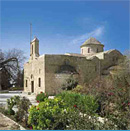 |
Angeloktisti Church
|
|
|
Angeloktisti means 'Built by the Angel'. This 11th century Byzantine church was built on a destroyed Early Christian basilica, the apse of which survives together with one of the finest pieces of Byzantine art - a 6th century mosaic of the Virgin Mary and Child between two archangels, which rivals the Ravenna Mosaic.
Built by the Lusignan King Jenus in 1421, it contains a wall painting of the king with his wife, Charlotte de Bourbon, on one of its walls. Considered to be one of the most interesting structures surviving from the Frankish Period, it was restored in 1977.
|
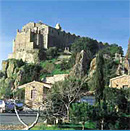 |
Stavrovounl Monastery
|
|
|
9 km off the Nicosia-Limassol road. Perched on a rocky peak, 750 meters above sea level, Stavrovouni means the Mountain of the Cross, and according to tradition was founded by Saint Helena, mother of Constantine the Great, who left a fragment of the Holy Cross to the monastery. The brotherhood is extremely devout, keeping vows as strict as those of the Mount Athos brotherhood in Greece. Women are not allowed in the monastery. Men may visit the monastery daily, from sunset, except from 12.00-13.00 (15.00 hrs in summer). Visits are not allowed on Green Monday and the following day.
There is an impressive ceremony and celebration on 14 September, the day of the Exaltation of the Holy Cross. The Monastery of Ayia Varvara (Saint Barbara), at the foot of Stavrovouni hill, is easily accessible. The monks here, as in Stavrovouni, have a high reputation for icon painting.
19 km south of Nicosia. The site of this ancient city kingdom has not yet been fully excavated, but on the high ground, outside the present village of Dhali, part of the ancient walls of the city can be seen. In this area Adonis, mythical lover of the goddess Aphrodite, was killed by a wild boar sent by her jealous husband.
At the nearby village of Perachorio the church of the Holy Apostles contains very beautiful 12th century frescoes.
|
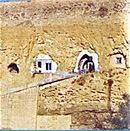 |
Spilia
|
|
|
Near Deftera village. Dedicated to Our Lady of the Golden Cave, the catacomb structure, an enlarged natural cave indicates the church, dates back to the early Christian period. Unfortunately its painted interior is hadly damaged. A religious fair is held near the church on 15th August.
Tamassos, with its rich copper works, was a city kingdom of ancient Cyprus and of great importance throughout early history. Excavations have produced the Royal Tombs and copper workshops associated with Aphrodite-Astarte.
When Saints Paul and Barnabas came to Cyprus, they were guided to Tamassos by Herakleidios, whom they later ordained as Bishop of Tamassos. He was martyred at the age of 60 and buried in the cave where he had lived and preached. The Monastery was founded in 400 AD, destroyed and rebuilt several times until Archbishop Chrysanthos renovated the church and cells in 1773. The skull and a bone from the hand of the saint are kept in a silver gilt case, in the church which is decorated with fine frescoes and icons.
|
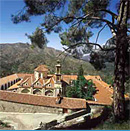 |
Machairas Monastery
|
|
|
41 km south of Nicosia. Founded by two monks in 1148, when an icon of the Virgin Mary was found in a nearby cave. Set in a picturesque dip in the Makhairas mountains, it is the scene of a large religious fair on 15th August.
1½ km east of Gourri village. The whole village has been declared an ancient 'monument' in order to preserve the remarkable woodwork and folk architecture of the 18th century houses. The house of Katsinioros and Achilleas Demetri, some parts of which go back to the 16th century, have been restored as vivid examples of rural architecture. They received the Europa Nostra award in 1987.
1½ km north west of Agrokipia village. An 18th century monastery with a gabled roof, restored in the early 1960s, and now serving as a retreat for three nuns.
Off the Nicosia-Anthoupolis Road. The church dates back to the Byzantine period, with rebuilding carried out in 1636 and in 1713, when it was purchased by Kykko Monastery. Founded by Archbishop Nikiforos, whose tomb can be seen in the narthex of the church. The iconostasis dates to 1650 and there is a 1785 fresco of the Archangel Michael, to whom the monastery is dedicated.
|
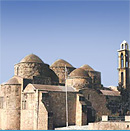 |
Peristerona
|
|
|
27 km from Nicosia. The church, dedicated to Saints Barnabas and Hilarion, was probably erected in the early 10th century, and is an outstanding example of Byzantine architecture. Next to the church stands the Turkish mosque of Peristerona, witness to the long and peaceful co-existence between the Greek Cypriots and Turkish Cypriots of the village, and the whole of Cyprus, in a time before partition.
48 km south of Nicosia. Neolithic settlement dating back to 6800 BC. Excavations have brought to light one of the earliest Neolithic cultures in the world. Finds from Khirokitia are displayed at the Cyprus Museum in Nicosia.
8 km from Skarinou. A picturesque village, partly restored and protected, famous for its local lace known as 'Lefkaritika' , and for its silver-ware. According to tradition, Leonardo Da Vinci visited the village and bought an altar cloth, which he donated to the Milan cathedral. The House of Patsalos which is being restored, houses the Lace and Silver-ware Museum of Lefkara.
The church of the Archangel Michael in Kato Lefkara is of the single-aisled domed type and has wall paintings of the late 12th century. At Pano Lefkara, there is the church of the Holy Cross with a beautiful 18th century iconostasi, and unique 13th century silver cross. A religious fair takes place on the 13th-14th September, the day of the Exaltation of the Holy Cross.
Near Lefkara. 15th century convent, with a church at the centre of the cloisters. The nuns, besides performing their religious rites, are famous for their icon painting and honey production.
|
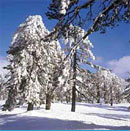 |
Troodos Mountains
|
|
|
The impressive Troodos mountain range stretches across most of the western side of Cyprus, offering cool sanctuary and idyllic hours spent in long walks in its scented pine forests in summer and winter sports and skiing in winter.
Here can be found many famous mountain resorts, Byzantine monasteries and churches on mountain peaks, and nestling in its valleys and picturesque mountain villages clinging to terraced hill slopes. Nine Byzantine churches in this area are included in the official UNESCO list of cultural treasures.
The area has been known since ancient times for its mines, and in the Byzantine period it became a great centre of Byzantine art, as churches and monasteries were built in the mountains, away from the threatened coastline.
Unique nature walks, have been created by the Forestry Department in co-operation wlth the Cyprus Tourism Organisation – a rich profusion of flora and fauna can be found on these very attractive walks, which attract many visitors every year. In the Troodos mountain range, besides Machairas to the east, and the actual Troodos district around Mount Olympus (height 1951 metres), there are four other districts, each of which has its own character and separate charm. These districts are: 1. Pitsillia to the east of Mount Olympus, the 2. Solea Valley and the 3. Marathassa Valley to the north of Mount Olympus, and the 4. Krassochoria (the Wine Villages) to the south (north-west of the Limassol district).
|


